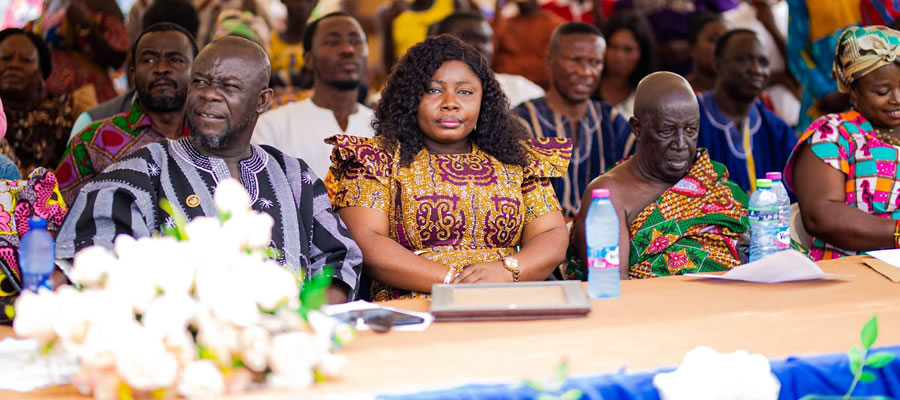

Location and Size
The District is located in the central part of Ashanti Region of Ghana between Latitudes 60 50’N and 70 10’ N, and Longitudes 10 40’ W and 10 25’ W. The District has an area of about 409.4 square kilometers representing 1.68% of the land area of Ashanti Region. The District is bounded by Kumasi Metropolitan Assembly to the South, Ejura Sekyedumase to the North, Atwima Nwabiagya to the South-West, Sekyere South to the East, Offinso Municipal to the West and Kwabre District to the South East.
The Afigya-Kwabre District was carved out of two (2) Districts namely; Kwabre and Afigya–Sekyere. The central location of the district within the Ashanti Region coupled with accessibility to most of the areas make interaction among the populace very easy.
Its closeness to the second largest city in Ghana, i.e. Kumasi makes it a dormitory district as well as high population growth rate and fast growth of settlements. This has resulted in intense pressure on socio-economic facilities as well as increase in waste generation.
Again, the nearness of the District to the urbanized community of Kumasi Metropolis has made parts of the district to assume urban status. Such towns include Atimatim, Heman, Nkukua Buoho, Nkwantakese, Ahenkro, Kodie and Afrancho. There is an assumption of increased revenue from these communities as a result of the increased commercial activities in the townships.
Climate
The Afigya-Kwabre District is located in the semi-deciduous forest zone. The zone is characterized by relatively high rainfall (about 1400mm per annum with a binomial pattern). The major rainy season occurs between March and mid-July with a peak in May /June. There is a dry spell from mid-July to mid-August. The minor rainy season starts from mid-August to about the end of October with a peak in September. A long dry period is experienced from November to February with possibilities of occasional rains.
Temperatures are normally high throughout the year with very little variations. The mean monthly temperatures range from 25oC in July/August to 28oC in March /April.
The District experiences relative humidity ranging from 90 – 98% during the night and early mornings of the rainy season. Day-time humidity falls below 75% during the harmattan season.
The climatic conditions favour the cultivation of diverse variety of cash and food crops which are of tropical nature. Again, the relatively high temperatures and sunshine favour the processing of most crops such as cocoa, maize etc.
The double rainfall regimes experienced by the district makes it possible for farmers to cultivate both food and cash crops two times in a year. Extensive dry season however may lead to long period of drought and retards farming activities in that period.
Vegetation
The original vegetation is forest and this has largely been degraded by lumbering, expansion of settlements and farming. The closed forest consisted of a continuous canopy of tall and medium – height trees with little or no undergrowth no longer exists. The area now largely consists of farm patches with isolated stands of individual trees or small areas of tree-clusters as shown in Fig. 1.5
Crops cultivated in the district include, cocoa, oil palm, citrus, avocado pear, coffee, plantain, maize, cassava, cocoyam, cowpea, vegetables etc.
The District has three (3) forest reserves namely; Afram Head Waters forest reserve, Gianima forest reserve and Asufu Shelterbelt forest reserve. All the forest reserves are located in the Northern part of the District.
Relief and Drainage
The landscape is a dissected plateau with heights reaching 800m to 1200m above sea level. The plateau forms part of the Mampong-Gambaga scarp. The landscape is predominantly undulating resulting in erosion along the slopes.
The relief in the district is generally undulating with altitude ranging between 800-1000 ft. However, the northern part reaches up to 1,200ft above sea level. Isolated hills in the south around Buoho also have altitudes up to 1,200ft. The undulating nature of the relief of the district makes flow of water easy. Besides the river valleys, there are very few waterlog areas. This again supports the growth of deep rooted crops/plants. The high points serve as observations for people who enjoy sceneries as in Fig 1.6
The District is drained by three main rivers and their tributaries. These are rivers Offin, Oyon, Prabon and Abankro as shown in Fig. 6. Continuous human activities along these rivers and streams have adversely affected their flows. Almost all the rivers experience seasonal flows.
The seasonal flow of rivers and streams in the district means that they cannot be relied upon for irrigation during the dry season. Again, fresh fish production is not well supported.
Soils and Geological Formation
The District has two geological formations, namely Voltaian and Dahomeyan. The Voltaian formation consists of shale, sandstone, mudstone and lime-stone. The Dahomeyan formation consists of metamorphic rocks such as gneiss and schist.
The mass presence of granite rock in the district supports the quarry industry. This will continue to be a major source of employment and income and so the citizenry must be encouraged to take advantage of the potential.
The soils of Afigya-Kwabre District are developed over granite, Lower Birimian phylite and coarse-grained Voltatian Sandstone. Soil associations or mapping units over each of these parent materials are shown in Figure 7.
1. Soils developed over granite and associated rocks
Kumasi – Ofin Compound Association
Bomso – Ofin Compound Association
Boamang – Suko Simple Association
Nyanao – Opimo Association
2. Soils developed over Voltaian rocks (standstone)
Bekwai – Oda Compound Association
3. Soils developed over lower Birimian rocks
Bediesi – sutawa Association
Yaya – Pimpimso Association
The soil types consist of Kumasi-Offin Compound Association, Bomso-Offin Association, Jamasi Simple Association, Boamang Simple Association, Bediesi-Sutawa Association and Yaya-Primpimson Association.
The Kumasi-Offin Compound Soil is good for tree crops such as citrus, cocoa, coffee and oil-palm. They are also good for food crops like, cocoyam, plantain, cassava and yam. Figure 4 shows the soils of the District.
The Boamang Simple Association is good for agriculture but it is highly susceptible to erosion.
The Bediesi-Sutawa Association has high water holding capacity and is suitable for mechanized agriculture. They support crops like maize, yam, legumes, cassava, plantain and groundnuts.
The soils are very rich and good for agricultural purposes. The district has been a major source of food supply and cocoa which still has a bright future.
The soils have textured surface horizons in which sandy-loams are common. The lower horizons have slightly heavier textures while the valley bottoms are clayey textured.
Generally, the district is endowed with good soils for agricultural development. Over 90%of the soils are developed from granite except a small area to the north- east and south west where they are developed over sandstone and lower
Birimian Phylite respectively.
The topsoils are mainly sandy loams and so are susceptible to erosion. Preventi measures are important in the cultivation of the soils. Practices such as cover cropping, mulching, avoidance of burning etc., to protect the topsoil are very useful.
The rocky hills of the Nyanao – Opimo association around Buoho is important with quarries established in the area. The rocky hills and outcrops around Ntiribuoho, Nkukua-Buoho and Afrancho, constitutes a potential for investment and employment creation in view of the growing residential development in and out of the district as well as for road construction.
Conditions of the Natural Environment
The natural environment of the district which used to be one of the purest in the region is gradually losing its purity and importance. This can be attributed to the increase in population and its attendant problems and effects on the environment.
The district can boast of natural environment ranging from forest reserves with rich species of flora and fauna to vast arable land that can support the production of both stable and cash crops.
The forest reserves are found in the northern part of the District and abound with high economic trees. Chain saw operators and some timber merchants are encroaching on the reserves so rapidly that it is feared that the reserves will lose their value in the next few years. These chain-saw operators and the merchants have taken advantage of the government’s policy of releasing part of the reserves for farmers to cultivate. Notwithstanding, the policy has increased food production in those area
The district also has a number of undeveloped tourist sites. These include the Ofin/Abankro Confluence, Buoho rock outcrops etc.
Human activities have changed the natural environment drastically. Indiscriminate felling of trees for timber and fuel wood, continuous cultivation and incidents of bush burning which has become ritualized have left very little of the original forest mostly found along river courses. With the current population density of over 332.5 persons per square kilometer and increasing demand for land for residential purposes, available land for agriculture has been reducing whilst natural vegetation has been depleted.
Conditions of the Built Environment
Like any other District in the country, the condition of the built environment differs from larger communities to smaller communities with the larger communities having very poor environmental conditions.
Conditions of the urban communities like Atimatim, Afrancho, Buoho, Boamang Ahenkro, Tetrem etc are characterized by large compound houses, poor drainage facilities, unkempt surroundings and heaps of refuse.
In the rural areas erosion is so severe that most buildings have exposed foundation. Even though conditions in the rural areas are better than the urban areas, traces of unkempt surroundings and pools of stagnant water can be found in some rural communities.
Housing conditions in the rural areas are characterized by exposed foundation with majority of them being built with mud. Settlements are nucleated with some of them very far from larger settlements. In the urban centres, modernity and westernization is catching up speedily. Most of the houses are built with sandcrete and roofed with aluminum sheet.
Climate Change Issues
It is an undeniable fact that the effects of climate change are evident in the District. The situation manifests itself in many ways which include.
1. Unusual late start of the rainy season.
2. Irregular and unreliable rainfall.
3. Long dry seasons.
4. Change in fruiting seasons of most tree crops like avocado pears and mangoes
5. Loss of soil fertility resulting in low crop yields.
6. Frequent invasion of crops by strange pest.
From the above, it is important for the Assembly to consider environmental impacts of all human and development activities before embarking on them. There should also be constant public education on climate change and its impact on development.
Development Implications
Conscious effort should be made to address the challenges and impacts of environmental degradation and climate change issues. Tree planting and aforestation should be embarked upon to green the district and to address the issues of desertification especially in the northern part of the district.
Conscious effort should be made to create green areas and parks to promote recreational activities and also beautify the environment. Especially water shed rivers and streams should be provided with buffer zones to avoid encroachment on these areas. The design of building and structures should respond to several rain storms experienced in the district.
Building and structures should have rain harvesting designs to store rain water for domestic use. The use of electronic appliances and burning of bushes, tyres that have effect on the ozone layer should be avoided. Above all, educational programmes should be conducted in all communities to raise the people’s consciousness on issues on environment, climate change and green economy.
Date Created : 11/10/2017 7:28:12 AM












 facebook
facebook
 twitter
twitter
 Youtube
Youtube
 +233 593 831 280
+233 593 831 280 0800 430 430
0800 430 430 GPS: GE-231-4383
GPS: GE-231-4383 info@ghanadistricts.com
info@ghanadistricts.com Box GP1044, Accra, Ghana
Box GP1044, Accra, Ghana